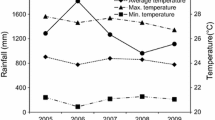Abstract
Fertilizer studies in Mexico indicate that coffee production can be stimulated by added nitrogen. One traditional method of coffee cultivation employs leguminous trees for shade, but these species may also play an important role in coffee production by biologically fixing nitrogen.
The presence and importance of nitrogen fixation was evaluated in four systems: coffee only, coffee plus the leguminous shade treeInga jinicuil Schletchter, coffee plus the leguminous treeInga vera H.B. and K., and coffee plus banana and orange trees. In all systems coffee leaves with epiphylls, wood litter, soil, roots, and root nodules were assayed for nitrogen fixing activity with the acetylene reduction technique.
All components of these systems exhibited activity except roots. Total apparent fixation was highest in theInga jinicuil site, and equivalent to >40 kg N ha−1 yr−1 assuming a 3∶1 C2H2∶N2 ratio. The activity was primarily associated withInga jinicuil nodules. Apparent fixation in the other three sites was less than 1 kg N ha−1 yr−1. Nitrogen fixed in theI. jinicuil site was 53% of the average amount of fertilizer nitrogen applied annually, suggesting that fixation by non-crop legumes can be an important nitrogen source for coffee agro-ecosystems.
Resumen
En estudios de fertilización en México se ha encontrado que la production de café puede ser estimulada por la adición de nitrógeno. Uno de los métodos tradicionales de cultivo de café es el de proveer al cultivo de sombra por medio de árboles de la familia Leguminosae los cuales pueden jugar un papel importante en la producción del café a través de la fijación biológica de nitrógeno.
La presencia e importancia de fijación de nitrógeno se evaluó en cuatro sistemas: café solo, café conInga junicuil Schletcher, café conInga vera H.B. & K. y café con bananos y naranjos. En todos los sistemas las hojas de café con epifilos, restos leñoso en el mantillo, suelo, raices y nódulos fueron estudiados por el método de reducción de acetileno para fijación de nitrógeno. Todos estos componentes presentaron actividad fijadora excepto las raices. El total de fijación aparente fué mayor en el sitio conI. jinicuil, equivalente a >40 kg N ha−1 ão−1 asumiendo una relación de 3∶1 para C2H2∶N2. La actividad estaba relacionada con los nódulos deI. jinicuil. La fijación aparente en los otros tres sitios fue menos de 1 kg N ha−1 año−1. La fijación de nitrógeno para el sitio conI. jinicuil equivale al 53% de la cantidad promedio de fertilizante nitrogenado aplicado anualmente, lo cual puede tomarse como indicativo de que la fijación de nitrógeno por leguminosas adicionales al cultivo puede ser una fuente importante de nitrógeno para el café.
Similar content being viewed by others
References
Dart P J 1974 The infection process.In Quispel A (Ed.) The Biology of Nitrogen Fixation, pp. 381–429. Amsterdam: North Holland Publ. Co.
DeMooy D J, Pesek J and Spaldon E 1973 Mineral nutrition in soybeans: Improvement, production, and uses. Agronomy 16, 267–352.
Dixon R O D 1969 Rhizobia, with particular reference to relationship with host plants. Annu. Rev. Microbiol. 23, 137–158.
Edwards D G 1977 Nutritional factors limiting nitrogen fixed by rhizobia.In Ayanaba A and Dart P J (Eds.) Biological Nitrogen Fixation in Farming Systems of the Tropics, pp 189–204. N.Y.: John Wiley and Sons.
Garcia E 1970 Los climas del estado de Veracruz. Anales Inst. Biol. Univ. Nac. Mex. Ser. Bot. 41, 3–42.
Hardy R W F, Holsten R D, Jackson E K and Burns R C 1968 The acetylene-ethylene assay for N2 fixation: laboratory and field evaluation. Plant Physiol. 43, 1185–1207.
Instituto Mexicano del Cafe 1974 Tecnologia Cafetalera Mexicana. Mexico City: Imprenta Venecia S.A. 194 p.
Jimenez E 1979 Ecological study of the coffee agro-ecosystem. I. Structure of a coffee plantation in Coatepec, Ver., Mexico. Biotica 4, 1–12.
Jimenez E and Martinez P 1979 Ecological studies of the coffee agro-ecosystem. II. Organic matter production in different types of coffee plantations. Biotica 4, 109–126.
Jones K 1970 Nitrogen fixing bacteria in the canopy of conifers in a temperate forest.In Dickinson C H and Preece T F (Eds.) Microbiology of Aerial Plant Structures, pp 41–66. N.Y.: Academic Press.
Koch B L and Oya J 1974 Non-symbiotic nitrogen fixation in some Hawaiian pasture soils. Soil Biol. Biochem. 6, 363–367.
Last F T and Deighton F C 1965 The non-parasitic micro-flora on the surfaces of living leaves. Trans. Br. Mycol. Soc. 48, 83–99.
Lie TA 1974 Environmental effects on nodulation and symbiotic nitrogen fixation.In Quispel, A. (Ed.) The Biology of Nitrogen Fixation, pp 555–582. Amsterdam: North Holland Publ. Co.
McColl J G 1970 Properties of some natural waters in a tropical wet forest of Costa Rica. BioScience 20, 1096–1100.
Postgate J 1974 Prerequisites for biological nitrogen fixation in free-living heterotrophic bacteria.In Quispel A (Ed.) The Biology of Nitrogen Fixation. pp 663–686. Amsterdam: North Holland Pub. Co.
Roskoski J P 1980 N2 fixation (C2H2 reduction) by epiphylls on coffee,Coffea arabica. Microbial Ecol. 6, 349–355.
Roskoski J P 1981 Nodulation and N2 fixation byInga jinicuil, a woody legume in coffee plantations. I. Measurements of nodule biomass and field C2H2 reduction rates. Plant and Soil 59, 201–206.
Ruinen J 1974 Nitrogen fixation in the phyllosphere.In Quispel A (Ed.) The Biology of Nitrogen Fixation, pp 86–121. Amsterdam: North Holland Pub. Co.
Steyn P L and Delwiche C C 1970 Nitrogen fixation by non-symbiotic microorganisms in some California soils. Environ. Sci. Tech. 4, 1122–1128.
Todd R L, Meyers and Waide J B 1978 Nitrogen fixation in a deciduous forest in the southeastern United States. Ecol. Bull. 26, 172–177.
van Kessel C and Roskoski J P 1981 Nodulation and N2 fixation byInga jinicuil, a woody legume in coffee plantations. II. Effect of soil nutrients on nodulation and N2 fixation. Plant and Soil 59, 207–216.
Author information
Authors and Affiliations
Rights and permissions
About this article
Cite this article
Roskoski, J.P. Nitrogen fixation in a Mexican coffee plantation. Plant Soil 67, 283–291 (1982). https://doi.org/10.1007/BF02182775
Issue Date:
DOI: https://doi.org/10.1007/BF02182775




